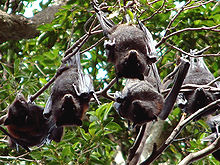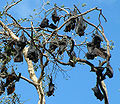- Black Flying Fox
-
Black Flying-fox 
Conservation status Scientific classification Kingdom: Animalia Phylum: Chordata Class: Mammalia Order: Chiroptera Family: Pteropodidae Genus: Pteropus Species: P. alecto Binomial name Pteropus alecto
Temminck, 1837Subspecies P. a. alecto
P. a. aterrimus
P. a. gouldi
P. a. morio
Black Flying-Fox range The Black Flying-Fox, Pteropus alecto, is a megabat in the family Pteropodidae. Members of the genus Pteropus include the largest bats in the world. The Pteropus genus has currently about 57 recognised species. The genus is primarily an island taxon, with 55 species having some or all of their distribution on islands.
Contents
Taxonomy
Juvenile specimens of this species from Moa Island in Torres Strait have been described as a separate species, Pteropus banakrisi.[2] This supposed species was known as the "Torresian Flying-Fox" or "Moa Island Fruit Bat".
Physical characteristics
The Black Flying-Fox has short black hair with a contrasting reddish-brown mantle with a mean forearm length of 164 mm (6.46 in) and a mean weight of 710 grams (1.57 lb). It is one of the largest bat species in the world, and has a wing-span of more than one metre.
Distribution
Black Flying-Foxes are native to Australia (NSW, Qld, NT and WA), Papua New Guinea (Western Province) and Indonesia (West Papua, Sulawesi, Sumba, and Savu).
Roosting habits
During the day individuals reside in large roosts (colonies or 'camps') consisting of hundreds to tens of thousands of individuals. They sometimes share their roosts with the Grey-headed Flying-Fox (Pteropus poliocephalus), the Spectacled Flying-Fox (Pteropus conspicillatus), and/or the Little Red Flying-Fox (Pteropus scapulatus). They roost in mangroves, paperbark swamps, patches of rainforest and bamboo forests, and very rarely in caves or underneath overhangs.
Reproduction
Black Flying-Foxes breed once a year. A single young is born and carried by its mother for the first month of life, after which it is left behind in the roost when the mother is out foraging at night.
Diet
Black Flying-Foxes eat pollen and nectar from native eucalyptus, Lilypillies, paperbark and turpentine trees. When native foods are scarce, particularly during drought, the bats may take introduced or commercial fruits such as mangos and apples. This species had been known to travel up to 50 km a night in search of food.
Conservation
The Black Flying-Fox is not listed as threatened on the IUCN Red List; nevertheless, the species is exposed to several threatening processes, including loss of foraging and roosting habitat, and mass die-offs caused by extreme temperature events[citation needed]. When present in urban environments Black Flying-Foxes are sometimes perceived as a nuisance. Because the roosting and foraging habits of the Black Flying-Fox bring the species into conflict with humans, it suffers from direct killing of animals in orchards and harassment and destruction of roosts.
As a disease vector
Negative public perception of the species has intensified with the discovery of three recently emerged zoonotic viruses that are potentially fatal to humans: Australian bat lyssavirus, [3] Hendra virus, and Menangle virus. However, only Australian bat lyssavirus is known from two isolated cases to be directly transmissible from bats to humans.
Wildlife rescue
Flying-foxes often come to the attention of Australian wildlife care and rescue organisations such as Wildcare Australia, ONARR, Wildlife Carers Darling Downs, Bat Care, Bat Rescue, Tweed Valley Wildlife Carers, and WIRES when reported as injured, sick, orphaned or abandoned. A very high proportion of adult flying-fox injuries are caused by entanglement in barbed wire fences or loose, improperly erected fruit tree netting, both of which can result in very serious injuries and a slow, agonizing death for the animal if not rescued quickly.
If you find a bat in distress, leave it be but immediately contact one of the above care and rescue organisations. Bat carers are specially trained in techniques to rescue and rehabilitate bats, and although the chance of contracting Australian bat lyssavirus is extremely small, carers are inoculated for their own protection.
Footnotes
- ^ Hutson, T., Suyanto, A., Helgen, K., McKenzie, N. & Hall, L. (2009). 'Pteropus alecto'. In: IUCN 2008. IUCN Red List of Threatened Species. Downloaded on 18 August 2009.
- ^ Helgen, 2004, Zootaxa 780:1-14
- ^ "Australian Bat Lyssavirus Infection in a Captive Juvenile Black Flying-Fox". Field, H. and McCall, B. and Barrett, J. (1999). Emerging Infectious Diseases, 5 (3).[1]
References
- Hall, L. S. & Richards, G. C. (2000). Flying-foxes: fruit and blossom bats of Australia. Sydney: University of New South Wales Press. ISBN 0868405612.
- Markus, N. (2002). "Behaviour of the black flying-fox Pteropus alecto: 2. Territoriality and courtship". Acta Chiropterologica 4 (2): 153–166.
- Markus, N. and Blackshaw, J. K. (2002). "Behaviour of the black flying-fox, Pteropus alecto: 1. An ethogram of behaviour, and preliminary characterisation of mother-infant interactions". Acta Chiropterologica 4 (2): 137–152.
- Speare, Rick, et al. (1997). "Australian bat lyssavirus infection in three fruit bats from north Queensland." Comm Dis Intell 1997; 21:117-120. Downloadable pdf at: [2]
- Vardon, M., C. Tidemann. (1998). "Reproduction, growth and maturity in the black flying-fox, Pteropus alecto (Megachiroptera: Pteropodidae)". Australian Journal of Zoology 46: 329–344. doi:10.1071/ZO98023.
- Vardon, M., C. Tidemann. (2000). "The black flying-fox (Pteropus alecto) in north Australia: juvenile mortality and longevity". Australian Journal of Zoology 48: 91–97. doi:10.1071/ZO99060.
- Welbergen, J.; Klose, S.; Markus, N.; Eby, P. (2008). "Climate change and the effects of temperature extremes on Australian flying-foxes". Proceedings. Biological sciences / the Royal Society 275 (1633): 419–425. doi:10.1098/rspb.2007.1385. PMC 2596826. PMID 18048286. http://www.pubmedcentral.nih.gov/articlerender.fcgi?tool=pmcentrez&artid=2596826.
- Welbergen, J. (2008). "Variation in twilight predicts the duration of the evening emergence of fruit bats from a mixed-species roost". Animal Behaviour 75 (4): 1543–1550. doi:10.1016/j.anbehav.2007.10.007.
External links
- ARKive - images and movies of the black flying-fox (Pteropus alecto)
- Brief history of Megachiroptera / Megabats
Gallery
-
Black Flying-Fox.jpg
Black Flying-Fox hanging from a palm tree after eating palm nuts
Categories:- IUCN Red List least concern species
- Bats of Australia
- Mammals of Indonesia
- Mammals of Western Australia
- Mammals of the Northern Territory
- Mammals of Queensland
- Mammals of New South Wales
- Pteropus
- Animals described in 1837
Wikimedia Foundation. 2010.


